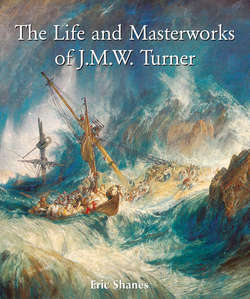The Life and Masterworks of J.M.W. Turner

Реклама. ООО «ЛитРес», ИНН: 7719571260.
Оглавление
Eric Shanes. The Life and Masterworks of J.M.W. Turner
Preface
The Life
The Masterworks of J. M. W. Turner
Turner and His Critics
Selected Bibliography
Chronology
Отрывок из книги
J. M. W. Turner, Lake of Lucerne, from the landing place at Fluelen, looking towards Bauen and Tell’s chapel, Switzerland, signed on barrel to right JMWT, c. 1810, exhibited R. A. 1815, watercolour over pencil with scratching-out, stopping-out and gum arabic in original frame, 66 × 100 cm (26 × 39 inches), Private Collection.
We gaze across a vast lake surrounded by huge, gleaming mountains. In the distance a heavy storm has moved off, leaving in its wake an atmosphere brimming with moisture and a world beginning to steam in the brilliant dawn sunshine. Not far away a group of travellers which has been drenched by the storm while out on the waters is alighting from a small ferry boat, their belongings and cargo strewn across the beach. On the right a girl sniffles into a handkerchief, possibly crying over the spilt milk that lies before her but more probably because her recent, chillingly damp experience has given her a head cold. Further off more boats approach, while near the very tip of the headland in the far distance to the right can just be made out the chapel first created in 1388 and rebuilt in 1638 that was dedicated to the memory of the Swiss fighter for liberty, William Tell.
.....
Yet this is not to say that the acute responsiveness to Turner has not been without its problems. Even in the artist’s own day there were many who could not stomach his daring. During the 1800s and 1810s he was severely criticised for his use of white, so much so that both he and other painters who followed directly in his footsteps were dubbed “the white painters”. Moreover, from the 1820s onwards the artist’s predilection for yellow led to many jokes and snide remarks being made in the newspapers about his pictures. When Turner combined intense yellows with fierce reds, blues and greens, journalistic comparisons abounded between his paintings and food, particularly scrambled eggs and salads. Then there was Turner’s dissolution of form within areas of intense light (which, in his late works, often took over entire images). Many members of a public that was becoming increasingly habituated to the intense verisimilitude of Pre-Raphaelite painting and/or Victorian bourgeois realism could not comprehend what was going on in a late-Turner canvas or watercolour. Even collectors who had previously lined up to purchase the latter kind of works found many of the artist’s late Swiss drawings difficult to understand and wouldn’t buy them.
J. M. W. Turner, The Founder’s Tower, Magdalen College, Oxford, 1793, watercolour, 35.7 × 26.3 cm, The British Museum, London, U. K.
.....